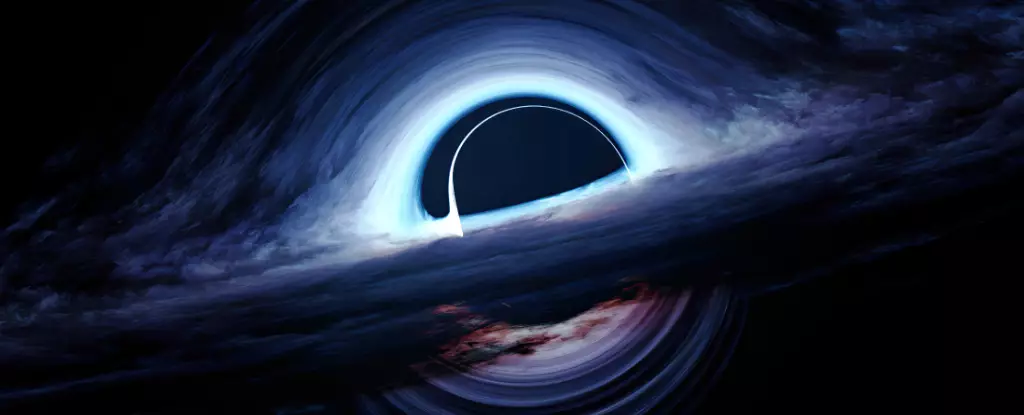Supermassive black holes (SMBHs) are among the most enigmatic and formidable entities in the cosmos, challenging our understanding of astrophysics. With masses that can exceed one billion times that of our Sun, these gargantuan objects lie at the centers of galaxies, exerting immense gravitational forces that influence the universe’s formation and evolution. Discoveries have shown that SMBHs were already thriving just a billion years after the Big Bang, a fact that raises intriguing questions about how they formed and evolved so quickly in the universe’s early stages.
Astronomers have detected quasars, which are extremely luminous nuclei of distant galaxies powered by actively feeding supermassive black holes, when the universe was merely a fraction of its current age. Accretion, the process by which black holes consume surrounding material, is responsible for their prodigious luminosity, and it is this feeding mechanism that catalyzes the formation of matter into energy, creating radiant emissions that can outshine entire galaxies. However, because the accretion process is neither constant nor infinite, a central puzzle emerges: how can such massive quasars exist when there was seemingly insufficient time for them to accumulate the material necessary for growth?
Numerous hypotheses have been put forward to explain the origins of supermassive black holes. A leading candidate is the existence of primordial black holes, which might have emerged shortly after the Big Bang. While this theory seems plausible for lower-mass black holes, it does not hold significant merit for the formation of SMBHs according to the standard cosmological model. Another pathway involves the merger and growth of stellar mass black holes, which are formed at the end stages of regular massive stars. Within densely populated star clusters, these smaller black holes could potentially coalesce, providing a mechanism for rapid growth. However, this “stellar seed” model can only satisfyingly explain a portion of the population of early SMBHs.
In addition to these models, researchers have recently explored the notion of “heavy seeds,” which are hypothesized to be several hundred to a thousand times the mass of normal massive stars. One proposed mechanism for their formation is termed “direct collapse.” In atmospheric conditions dominated by dark matter, gas clouds may collapse directly into black holes, bypassing the star formation stage entirely. However, the rarefied nature of these conditions, where only select dark matter halos grow sufficiently large, implies that such scenarios might yield only a limited number of SMBHs.
The search for black holes in early galaxies has historically posed challenges for astronomers. Advances in technology have enabled researchers to monitor changes in brightness in distant star systems over extended periods, helping to compile a clearer picture of the nascent universe. Recent studies have unveiled the striking reality that there are likely far more black holes than previously thought—potentially a few times over the number that could arise from traditional direct collapse theories.
The launch of the James Webb Space Telescope (JWST) has revealed unprecedented insights into the early cosmos, reasserting the idea that an abundance of black holes originate from massive progenitors. The insights gained from JWST, particularly regarding faint quasars, are set to redefine our understanding of galaxy formation.
Research into the environments that gave birth to early black holes has prompted consideration of exotic formation scenarios, specifically dealing with the interaction of dark matter during gas cloud contraction. The idea that dark matter could enrich the material from which stars and black holes arise opens up exciting prospects. If dark matter particles become ensnared within collapsing gas clouds, they could hinder the initiation of nuclear fusion, thus allowing the establishment of “dark stars” that surpass ordinary stellar lifetimes, enabling them to grow into significant black hole seeds.
Ultimately, as these dark stars succumb to gravitational forces, they too would contribute to the population of supermassive black holes observed in our universe. This revolutionary understanding highlights the dynamic relationships between different cosmic elements at play during the universe’s formative phases.
The continuum of research on black hole formation is just beginning to unravel. Upcoming endeavors, such as the Euclid mission and the Nancy Grace Roman Space Telescope, are poised to enrich our statistical models of black hole demographics. Instruments like the Square Kilometer Array will delve into profound questions surrounding early black holes, while JWST remains at the forefront of our observational capabilities. The next five years are critical, as they may usher in the discovery of black hole formation in real-time, with astronomers on alert for monumental events that accompany star collapses in pristine conditions.
The journey to understanding supermassive black holes only hardens our resolve to push the boundaries of cosmological exploration. Each new discovery shapes our narrative of the universe’s infancy, offering insights into the fundamental processes that sculpt our cosmic environment. As research continues to evolve, the cosmic tapestry of black hole formation may soon reveal secrets held for billions of years.


Leave a Reply